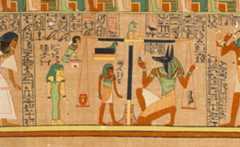Our editors will review what you’ve submitted and determine whether to revise the article.
- The Victorian Web - Melodramatic Tactics: Theatricalized Dissent in England's Marketplace, 1800-1885
- Literary Devices - Melodrama
- University of Missouri�St. Louis - Melodrama as movie modality
- PBS - Race Melodrama and Minstrel Shows
- Digital Commons at Molloy - Melodrama and the aesthetics of emotion
- CORE - Melodrama as a Compositional Resource in Early Hollywood Sound Cinema
melodrama
melodrama, in Western theatre, sentimental drama with an improbableplot that concerns thevicissitudes suffered by the virtuous at the hands of the villainous but ends happily with virtue triumphant. Featuring stock characters such as the noble hero, the long-suffering heroine, and the cold-blooded villain, the melodrama focusses not on character development but on sensational incidents and spectacular staging. In music, melodrama signifies lines spoken to amusical accompaniment.
The melodramatic stage play is generally regarded as having developed in France as a result of the impact ofJean-Jacques Rousseau’sPygmalion (1762; first performed 1770) on a society torn by violent political and social upheaval and exposed to the influences of the EnglishGothic novel and ofSturm und Drang (Storm and Stress) andRomanticism from Germany. The pioneer and primeexponent of the 18th-century French melodrama with its music, singing, and spectacular effects wasGuilbert de Pixérécourt. HisCoelina, ou l’enfant de mystère (1800) was translated asA Tale of Mystery (1802) byThomas Holcroft and established the newgenre in England. It was not utterly new to England, however; the restrictions of the Licensing Act of 1737 had been habitually evaded by combining drama with music, singing, and dancing.
Another prominent dramatist whose melodrama influenced other countries was the GermanAugust von Kotzebue. HisMenschenhass und Reue (1789) became tremendously popular in England asThe Stranger (1798); he also provided the original ofRichard Brinsley Sheridan’sPizarro (1799). In the early 19th century, melodrama spread throughout the European theatre; in Russia the authorities welcomed it as diverting attention from more serious issues.

During the 19th century, music and singing were gradually eliminated. As technical developments in the theatre made greater realism possible, more emphasis was given to the spectacular—e.g., snowstorms, shipwrecks, battles, train wrecks,conflagrations, earthquakes, and horse races. Among the best known and most representative of the melodramas popular in England and theUnited States areThe Octoroon (1859) andThe Colleen Bawn (1860), both byDion Boucicault. More sensational wereThe Poor of New York (1857),London by Night (1844), andUnder the Gaslight (1867). The realistic staging and the social evils touched upon, however perfunctorily and sentimentally, anticipated the later theatre of the Naturalists.
With the growing sophistication of the theatre in the early 20th century, the theatrical melodrama declined in popularity. It was a vigorous form, though, inmotion picture adventure serials until the advent of sound. Theexaggerated gestures, dramatic chases, emotional scenes, simple flat characters, and impossible situations were later revived and parodied. Melodrama makes up a good part of contemporary television drama.
